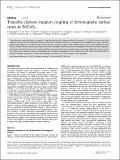Files in this item
Tuneable electron-magnon coupling of ferromagnetic surface states in PdCoO2
Item metadata
| dc.contributor.author | Mazzola, Federico | |
| dc.contributor.author | Yim, Chi-Ming | |
| dc.contributor.author | Sunko, Veronika | |
| dc.contributor.author | Khim, Seunghyun | |
| dc.contributor.author | Kushwaha, Pallavi | |
| dc.contributor.author | Clark, Oliver J. | |
| dc.contributor.author | Bawden, Lewis | |
| dc.contributor.author | Marković, Igor | |
| dc.contributor.author | Chakraborti, Dibyashree | |
| dc.contributor.author | Kim, Timur K. | |
| dc.contributor.author | Hoesch, Moritz | |
| dc.contributor.author | Mackenzie, Andrew P. | |
| dc.contributor.author | Wahl, Peter | |
| dc.contributor.author | King, Philip D. C. | |
| dc.date.accessioned | 2022-02-14T17:30:15Z | |
| dc.date.available | 2022-02-14T17:30:15Z | |
| dc.date.issued | 2022-02-11 | |
| dc.identifier | 277617005 | |
| dc.identifier | e270bda7-0723-4168-8ebd-6313de93fcf4 | |
| dc.identifier | 85124959406 | |
| dc.identifier | 000754196500001 | |
| dc.identifier.citation | Mazzola , F , Yim , C-M , Sunko , V , Khim , S , Kushwaha , P , Clark , O J , Bawden , L , Marković , I , Chakraborti , D , Kim , T K , Hoesch , M , Mackenzie , A P , Wahl , P & King , P D C 2022 , ' Tuneable electron-magnon coupling of ferromagnetic surface states in PdCoO 2 ' , npj Quantum Materials , vol. 7 , 20 . https://doi.org/10.1038/s41535-022-00428-8 | en |
| dc.identifier.issn | 2397-4648 | |
| dc.identifier.other | ArXiv: http://arxiv.org/abs/2112.04869v1 | |
| dc.identifier.other | ORCID: /0000-0002-8635-1519/work/108508607 | |
| dc.identifier.uri | https://hdl.handle.net/10023/24872 | |
| dc.description | Funding: We gratefully acknowledge support from the European Research Council (through the QUESTDO project, 714193), the Royal Society, the Max Planck Society, and the UKRI Engineering and Physical Sciences Research Council (Grant No. EP/S005005/1). V.S., O.J.C., and L.B. acknowledge the EPSRC for PhD studentship support through Grants EP/L015110/1, EP/K503162/1, and EP/G03673X/1, respectively. I.M. and D.C. acknowledge studentship support from the International Max-Planck Research School for Chemistry and Physics of Quantum Materials. | en |
| dc.description.abstract | Controlling spin wave excitations in magnetic materials underpins the burgeoning field of magnonics. Yet, little is known about how magnons interact with the conduction electrons of itinerant magnets, or how this interplay can be controlled. Via a surface-sensitive spectroscopic approach, we demonstrate a strong and highly-tuneable electron-magnon coupling at the Pd-terminated surface of the delafossite oxide PdCoO2, where a polar surface charge mediates a Stoner transition to itinerant surface ferromagnetism. We show how the coupling can be enhanced 7-fold with increasing surface disorder, and concomitant charge carrier doping, becoming sufficiently strong to drive the system into a polaronic regime, accompanied by a significant quasiparticle mass enhancement. Our study thus sheds new light on electron-magnon interactions in solid-state materials, and the ways in which these can be controlled. | |
| dc.format.extent | 6 | |
| dc.format.extent | 2210859 | |
| dc.language.iso | eng | |
| dc.relation.ispartof | npj Quantum Materials | en |
| dc.subject | QC Physics | en |
| dc.subject | TK Electrical engineering. Electronics Nuclear engineering | en |
| dc.subject | DAS | en |
| dc.subject.lcc | QC | en |
| dc.subject.lcc | TK | en |
| dc.title | Tuneable electron-magnon coupling of ferromagnetic surface states in PdCoO2 | en |
| dc.type | Journal article | en |
| dc.contributor.sponsor | The Royal Society | en |
| dc.contributor.sponsor | European Research Council | en |
| dc.contributor.sponsor | EPSRC | en |
| dc.contributor.sponsor | EPSRC | en |
| dc.contributor.institution | University of St Andrews. School of Physics and Astronomy | en |
| dc.contributor.institution | University of St Andrews. Centre for Designer Quantum Materials | en |
| dc.contributor.institution | University of St Andrews. Condensed Matter Physics | en |
| dc.identifier.doi | https://doi.org/10.1038/s41535-022-00428-8 | |
| dc.description.status | Peer reviewed | en |
| dc.identifier.grantnumber | URF/R/180026 | en |
| dc.identifier.grantnumber | 714193 | en |
| dc.identifier.grantnumber | EP/S005005/1 | en |
| dc.identifier.grantnumber | EP/L015110/1 | en |
This item appears in the following Collection(s)
Items in the St Andrews Research Repository are protected by copyright, with all rights reserved, unless otherwise indicated.

